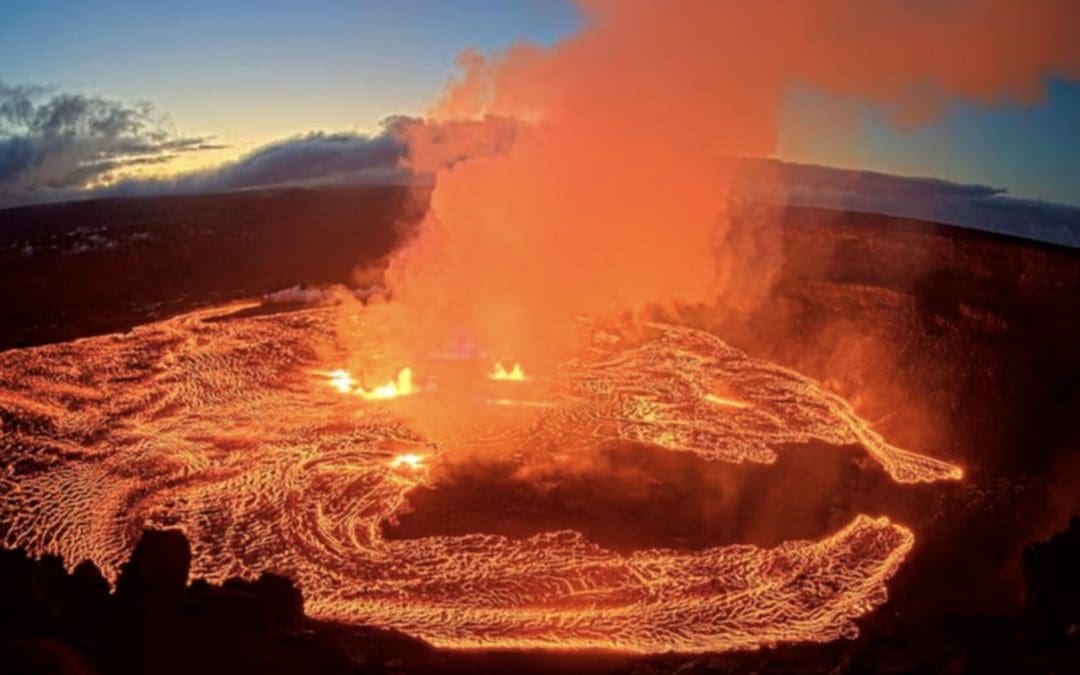Molten lava streams illuminate Hawaii’s night sky as Kilauea, Earth’s most mesmerizing volcanic spectacle, beckons adventurers from across the globe. This ancient mountain of fire has danced continuously since 1983, painting the landscape with ribbons of liquid stone and drawing millions who yearn to witness nature’s raw artistry.
The volcano’s mighty 2018 performance, which draped 55.6 square miles in glowing lava, only fueled visitors’ fascination with this primal force. Rather than deterring tourism, the eruption sparked a remarkable surge in visitor interest. Adventure seekers eagerly book $300 helicopter tours and $220 boat excursions, while Hawaii Volcanoes National Park welcomes two million annual visitors who stand in awe before Pele’s powerful domain.
Ready to experience this magnificent volcanic theater? Let our guide lead you through thrilling vantage points, crucial safety measures, and prime viewing locations. Whether soaring above crimson lava fountains or gazing from sacred ground viewpoints, Kilauea promises moments that will forever smolder in your memory.
Understanding Kilauea’s Current Activity
Pele’s fiery dance continues to evolve at Kilauea, where the ninth eruption episode recently paused on February 12, 2025, at 8:43 a.m. HST. For 22.5 breathtaking hours, lava fountains painted the sky before falling silent. Today, the north and south vents whisper steam and gases, their gentle glow hinting at magma lurking just beneath the surface.
Latest eruption updates
The volcano’s current chapter began December 23, 2024, unleashing a series of spectacular displays within Halema’uma’u crater. Nature’s timing varies wildly – some shows last mere hours while others stretch across eight days, with rest periods spanning anywhere from a single day to nearly two weeks. The mountain’s breath carries impressive power, releasing roughly 10,000 tons of sulfur dioxide daily during active periods.
Viewing areas and times
Sacred vantage points await those eager to witness Pele’s power:
- Kūpinaʻi Pali (Waldron Ledge): A gentle 0.5-mile stroll from Kīlauea Visitor Center
- Wahinekapu at Steam Vents: Quick 500-foot walk from parking
- Keanakākoʻi Crater Overlook: Perfect views just 0.5 miles away
- Kīlauea Overlook: Sweeping panoramas of nature’s theater
Dawn’s early light offers peaceful moments with fewer fellow observers. Night owls find magic after 10 PM, when darkness amplifies the volcanic glow.
Safety guidelines
Mother Nature demands respect – stay within rope-marked viewing zones. Volcanic gases pose special challenges for visitors with breathing concerns, little ones, and expecting mothers. Pack wisely: headlamps light your nighttime path, sturdy shoes protect your feet, and warm, waterproof layers shield you from mountain weather.
Planning Your Volcano Visit
Sacred mountains demand thoughtful preparation. Let’s explore the perfect moments to visit, essential gear for your journey, and magical places to rest between volcanic adventures.
When to visit
Kilauea never sleeps – her gates welcome visitors around the clock. Dawn seekers find solitude before 9 AM, while the mountain hosts her biggest audiences between 10 AM and 3 PM. Magic unfolds after sunset, when darkness unveils the crater’s ethereal glow, especially after 9 PM.
What to bring
Mountain wisdom calls for careful packing. Your volcanic adventure kit should include:
- Sturdy boots and cozy layers to embrace mountain weather
- Trusty headlamp to light your nighttime path
- Rain shell for sudden mountain mists
- Energy-rich snacks and pure water
- First-aid essentials for peace of mind
Remember – at 4,000 feet, Kilauea’s summit whispers with cool breezes. Check the mountain’s breath (air quality) before visiting, especially with little explorers or those with sensitive lungs.
Where to stay
Stay at least two nights at Volcano Village Properties to fully experience Kilauea. The volcano is unpredictable, and lava sightings are never guaranteed in just one night. By staying longer, you give yourself the best chance to witness its fiery display. Imagine standing in the dark, watching molten rock glow against the night sky. It’s a sight few ever forget. Don’t rush this once-in-a-lifetime experience.
Beyond the lava, Volcano Village offers so much more. Spend your extra time exploring lush rainforests, hidden trails, and the stunning landscapes of Hawaii Volcanoes National Park. Wake up to the sounds of nature, breathe in the crisp mountain air, and enjoy the serenity of this unique place. A single night isn’t enough to take it all in. Stay two nights or more, and let the magic of the volcano reveal itself to you.
Best Ways to Experience the Eruption
Kilauea offers two remarkable ways to witness its ancient power: floating above its fiery heart or standing upon its sacred ground. Each perspective reveals different secrets of this mighty volcano’s character.
Helicopter tours over active zones
Soaring through island skies unlocks Kilauea’s hidden wonders. Quick flights from Hilo promise adventure without breaking the bank. Fifty-minute journeys sweep you over both Kilauea and her sister volcano, Mauna Loa. Today’s flights showcase nature’s newest artwork – Kilauea’s bubbling crater alongside Mauna Loa’s fresh lava paths from November 2022.
These sky-high adventures reveal Kilauea’s remote treasures – places where human feet cannot tread. Watch molten rivers carve through dark forests, and witness the raw beauty of fresh lava flows. While Mother Nature keeps her own schedule, making lava sightings unpredictable, helicopter tours remain your best chance to spot active flows during ground closures.
Ground viewing locations
Earth-bound explorers discover their own magic along carefully chosen observation points. Park rangers maintain several sacred spots where you can feel the volcano’s pulse:
- Kūpinaʻi Pali: A short walk leads to views 2.6 miles from the crater’s edge
- Wahinekapu: Just 500 feet from Steam Vents parking, perfect for quick visits
- Keanakākoʻi Crater overlook: Brings you within 1.5 miles of nature’s theater
Dawn’s first light or evening’s darkness offer the quietest moments to commune with the volcano. Night visitors witness an especially magical show as crimson light dances across the crater. Each viewpoint welcomes guests with parking spaces, restroom facilities, and educational displays.
Cultural Significance
Sacred whispers echo across Kilauea’s slopes. Native Hawaiians see more than rock and fire. This volcano is a living ancestor. It breathes steam and passion. It demands deep respect as the home of Pelehonuamea, the fire goddess. She rules from her Halema’uma’u throne.
Ancient Hawaiians read the land’s volcanic stories. They saw how the islands formed, like pearls strung in a line. Their chants and hula preserved each eruption’s power. These performances honored Pele and recorded nature’s warnings.
Life thrives in this volcanic land. Plants push through black rock. Winds dance across crater rims. Every element holds its own spirit. Traditional ceremonies honor this connection. Prayers rise with the steam, seeking Pele’s guidance. Footsteps trace both physical and spiritual paths. Sacred markers, rock carvings, paintings, cairns, and shrines stand as signs of devotion.
Modern scientists learn from indigenous knowledge. Ancient chants recall powerful eruptions. They describe ’Aila’au’s fury in the 1400s and Kilauea’s collapse in the 1500s. This blend of science and tradition shapes the National Park’s mission. Traditional place names and ancestral wisdom are revived.
Hawaiian life once revolved around Pele’s presence. She commanded deep devotion. Her stories form the richest divine legends in Polynesia. Our ancestors walked these sacred slopes with reverence, honoring the volcanic gods.
Pele’s influence
“She who shapes the sacred land” – Pele still rules her fiery domain within Halema’uma’u of Kīlauea. Modern visitors walk paths where ancient spirits dwell, exploring grounds many Hawaiians know as home to the “family of fire gods”. Local whispers tell of Pele’s watchful eye – sometimes appearing as a stunning young maiden, other times as a wise elder wrapped in red muumuu, warning of nature’s coming fury.
Tourism’s dance with volcanic rhythms tells a rich and complex story. When 2018’s eruption reshaped the land, Hawaii Tourism Authority breathed new life into visitor dreams with USD 1.5 million in fresh marketing. Today, curious souls flock to “Pele’s playground,” finding shelter in Volcano Village’s welcoming embrace, mere footsteps from nature’s greatest theater.
Conclusion
Kilauea rises beyond mere mountain and myth – here beats Earth’s molten heart, where ancient Hawaiian wisdom dances with nature’s raw creativity. Sacred viewing grounds and soaring helicopter adventures invite souls to witness Pele’s artistic fury, each vantage point painting unique stories across volcanic skies.
Mountain wisdom whispers of perfect moments – dawn’s first blush or evening’s crimson glow. Volcano Village cradles travelers between adventures, its cozy beds and breakfast tables mere breaths away from steaming craters. Whether seeking luxury lodges or simple mountain cabins, each refuge opens doors to volcanic discovery.
Tourism’s gentle footsteps help preserve these sacred grounds where nature’s power meets cultural memory. Local guardians welcome respectful visitors, sharing Pele’s stories while protecting her fiery domain. This delicate balance ensures tomorrow’s children will still hear the mountain’s ancient songs.
Kilauea calls to wandering spirits, offering moments that spark lifetime memories. Here, beneath steam-filled skies, modern adventurers join an endless chain of human wonder stretching back through centuries. Whether drawn by scientific curiosity, cultural reverence, or pure adventure, all find their place in this timeless volcanic theater where Pele still paints with liquid fire.

